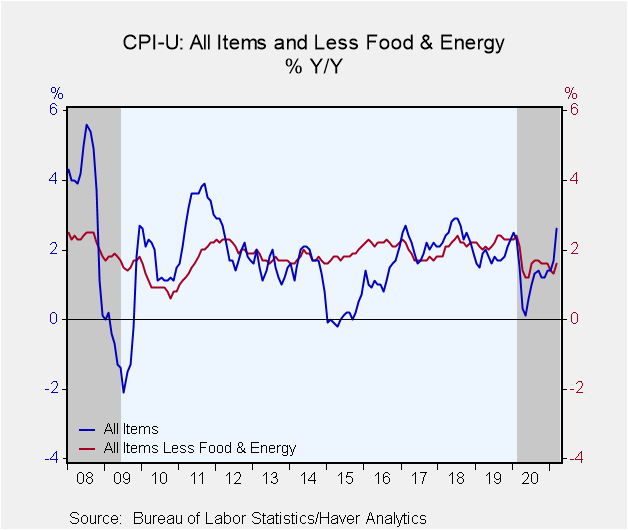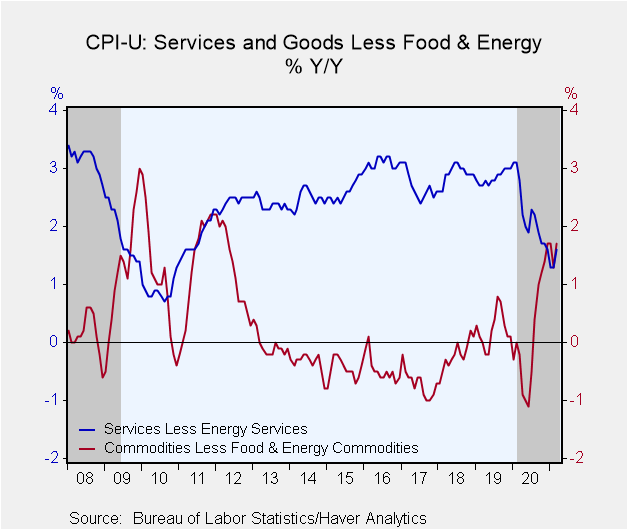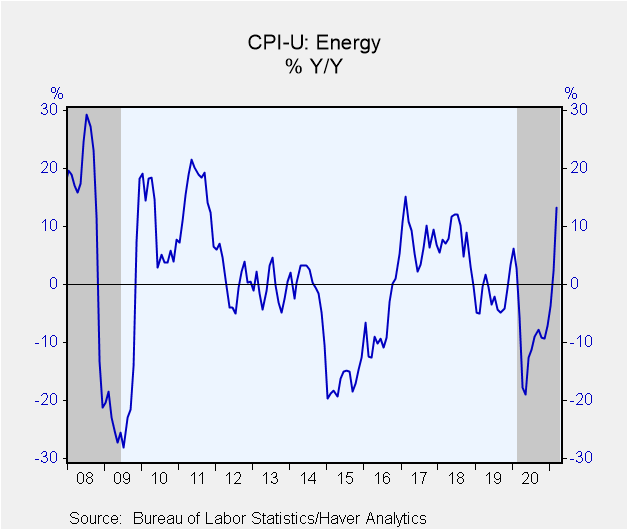 Global| Apr 13 2021
Global| Apr 13 2021U.S. Consumer Price Inflation Picks Up as Both Energy & Core Prices Strengthen in March
by:Tom Moeller
|in:Economy in Brief
Summary
• Higher energy prices lead last month's gain. • Services price inflation continues to accelerate. • Core goods prices pick up. Price inflation at the retail level is accelerating as demand firms. The Consumer Price Index rose 0.6% [...]
• Higher energy prices lead last month's gain.
• Services price inflation continues to accelerate.
• Core goods prices pick up.
Price inflation at the retail level is accelerating as demand firms. The Consumer Price Index rose 0.6% (2.6% y/y) during March following an unrevised 0.4% February increase. It was the quickest rise since August 2012. The gain compared to an expected 0.5% rise in the Action Economics Forecast Survey. The CPI excluding food & energy rose 0.3% last month (1.6% y/y) after a 0.1% uptick in February. It was the strongest increase since August of last year. A 0.2% March rise had been expected.
Another strong increase in energy prices provided impetus to last month's increase with a 5.0% jump (13.2% y/y), following three months of strong increase. Gasoline prices jumped 9.1% (22.5% y/y), strong for the fourth straight month. Fuel oil prices rose 3.2% (NSA, 20.2% y/y) after surging 9.9%. Natural gas prices strengthened 2.5% last month (9.8% y/y) while the cost of electricity held steady (2.5% y/y) after surging 0.7% in February.
Services prices strengthened 0.4% (1.6% y/y) during March, the strongest increase since July. Transportation services prices surged 1.8% (-1.6% y/y) as the cost of motor vehicle insurance jumped 3.3% (-2.5% y/y). Recreation services prices rose 0.8% (1.2% y/y) after rising 0.6% in February. The cost of public transportation strengthened 0.7% (-8.2% y/y), the first increase in four months. Shelter costs rose 0.3% (1.7% y/y), the strongest rise since February of last year. The owners' equivalent rent of primary residences increased 0.2% and rose a greatly lessened 2.0% y/y. Education & communication services prices improved 0.1% (2.0% y/y). Medical care services prices edged 0.1% higher (2.7% y/y) following two straight months of 0.5% increase.
Goods prices excluding food & energy improved 0.1% (1.7% y/y) in March after falling 0.2% during February. Apparel prices fell 0.3% (-2.5% y/y) following a 0.7% drop. Continuing to decline were prices for education & communication goods which dropped 1.8% (-4.9% y/y), off for a third straight month. Sporting goods prices fell 1.3% (+4.8% y/y). Recreation product prices eased 0.2% (+0.8% y/y). New vehicle prices were roughly steady (1.5% y/y) for a second month but used car & truck prices rose 0.5% (9.4% y/y) following three straight months of 0.9% decline. Medical care product costs improved 0.1% (-2.4% y/y) following six straight months of decline. Household furnishings prices rose 0.4% last month (2.8% y/y) while household appliance prices jumped 1.1% (7.9% y/y), strong for the second straight month.
Food price inflation was tame last month as prices edged 0.1% higher (3.5% y/y) last month for the second time in the last three months. Food-at-home prices rose 0.1% (3.3% y/y). Dairy prices fell 0.5% (+1.6% y/y), off for a third straight month, while cereal & bakery product costs eased 0.1% (+2.6% y/y). Fruit & vegetable prices jumped 1.0% (3.8% y/y) after rising 0.5% in February. Meat, poultry & fish prices eased slightly (+5.4% y/y) while egg prices rose 2.0% (4.7% y/y), strong for the third straight month. Nonalcoholic beverage prices eased 0.2% (+3.2% y/y). Prices for food away-from-home rose 0.1% NSA for a second straight month (3.7% y/y).
The Consumer Price Index data can be found in Haver's USECON database with additional detail in CPIDATA. The Action Economics survey figure is in the AS1REPNA database.
| Consumer Price Index, All Urban Consumers (% chg) | Mar | Feb | Jan | Mar Y/Y | 2020 | 2019 | 2018 |
|---|---|---|---|---|---|---|---|
| Total | 0.6 | 0.4 | 0.3 | 2.6 | 1.2 | 1.8 | 2.4 |
| Total less Food & Energy | 0.3 | 0.1 | 0.0 | 1.6 | 1.7 | 2.2 | 2.1 |
| Goods less Food & Energy | 0.1 | -0.2 | 0.1 | 1.7 | 0.1 | 0.2 | -0.2 |
| Services less Energy | 0.4 | 0.2 | 0.0 | 1.6 | 2.2 | 2.8 | 2.9 |
| Food | 0.1 | 0.2 | 0.1 | 3.5 | 3.4 | 1.9 | 1.4 |
| Energy | 5.0 | 3.9 | 3.5 | 13.2 | -8.5 | -2.1 | 7.5 |
Tom Moeller
AuthorMore in Author Profile »Prior to joining Haver Analytics in 2000, Mr. Moeller worked as the Economist at Chancellor Capital Management from 1985 to 1999. There, he developed comprehensive economic forecasts and interpreted economic data for equity and fixed income portfolio managers. Also at Chancellor, Mr. Moeller worked as an equity analyst and was responsible for researching and rating companies in the economically sensitive automobile and housing industries for investment in Chancellor’s equity portfolio. Prior to joining Chancellor, Mr. Moeller was an Economist at Citibank from 1979 to 1984. He also analyzed pricing behavior in the metals industry for the Council on Wage and Price Stability in Washington, D.C. In 1999, Mr. Moeller received the award for most accurate forecast from the Forecasters' Club of New York. From 1990 to 1992 he was President of the New York Association for Business Economists. Mr. Moeller earned an M.B.A. in Finance from Fordham University, where he graduated in 1987. He holds a Bachelor of Arts in Economics from George Washington University.










